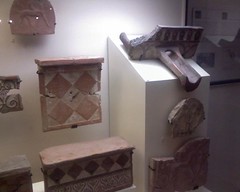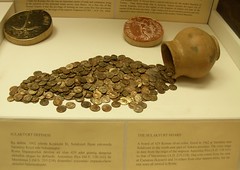I am in Ankara after attending Kültürel Mirası Koruma’da Yeni Yöntem ve Uygulamalar Sempozyumu/Symposium of The Preservation of Cultural Heritage: New Methods and Applications. The talks were all interesting and I'm grateful to my Turkish hosts for their hard work in putting the meeting together.
Today a group went to Gordion and to the Museum of Anatolian Civilizations (Wikipedia). This was my first visit to both so it was a great coda to an all-round wonderful trip.
The most impressive monument at Gordion is the so-called "Midas Tomb" (Tumulus MM), visible from the main highway as one drives to and from the site. Midas died c. 695 BC and Peter Kuniholm's dendrochronological investigations have put the cutting-date of the trees in the burial chamber some fifty years earlier. Hence the "so-called". Regardless of date, it's a must see site if you ever get the chance.
The museum is excellent and recently re-installed. The gallery past the opening one holds a series of cases that are generous in their use of pottery to illustrate trends in the history of the city. Flickr has a few illustrative images:

Middle Phrygian Dinos with creatures peeking over the rim.

Middle Phrygian Architectural Terracottas

Attic Import
A further note on absolute chronology: As discussed by Mary Voigt (p. 195), the destruction level that had been associated with the Kimmerian invasion and death of Midas has been pushed back to 830-800. There is some discrepancy between this chronology and some of the signage and labeling at the site and museum. But if one keeps this recent work in mind, it is interesting to ponder its implications for understanding the site.
The Museum of Anatolian Civilizations is superb, both in the quality of its collection and in the care with which it is displayed. Again, the installation is recent. It seems to be a popular spot since I quickly found many images on flickr. Try "museum anatolian civilizations". Explore for yourself but here is just a tiny sampling of what I enjoyed:

Hittite Ceramic Bulls. They are about waist high.

A 1st-2nd century AD tomb containing ceramics. This is a great image and you may want to download the full-size version. And here's a detail.

A 3rd century hoard of denarii in a small pot. This example is typical of the vessels used to protect buried hoards around the Mediterranean. The closing date (235) stands at around the transition from denarii to antoniniani. I might have hid my money, too.
Don't be misled by this post. The strength of the museum is its material from sites such as Catalhöyük, Alacahöyük, Boğazköy, Carchemish and elsewhere. Again, go if you can or enjoy the images on flickr.

1 comment:
I am so glad you enjoyed your trip to Gordion. It is indeed a fascinating place. Please visit us during the summer sometime!
Post a Comment